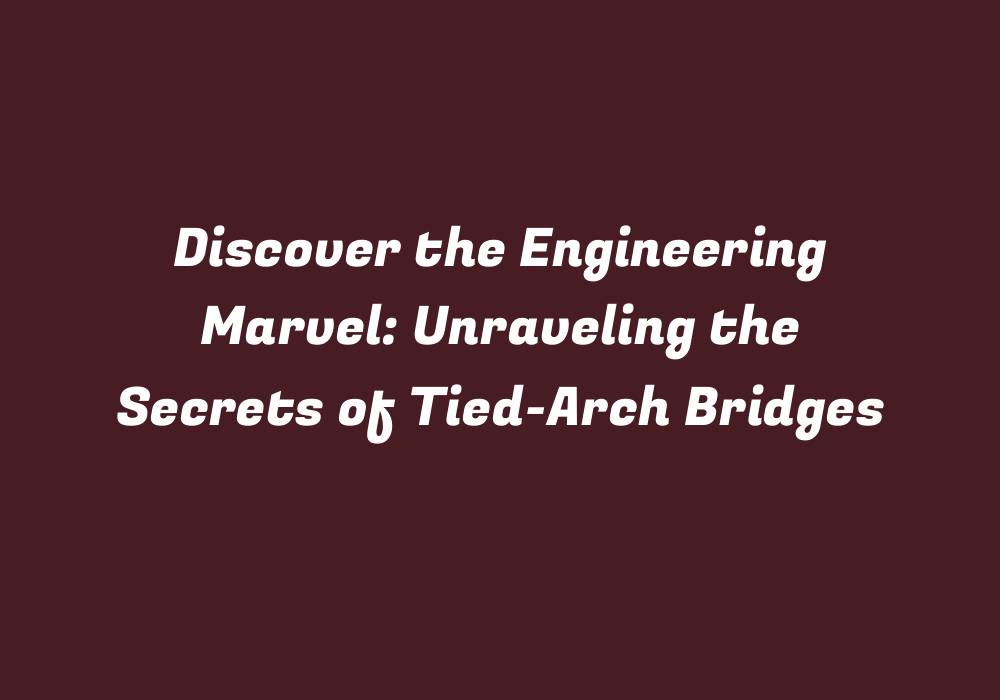Introduction: Unraveling the Mysteries of Tied-Arch Bridges
Tied-arch bridges, as their name suggests, are a unique type of bridge structure that has intrigued engineers and architects for centuries. They have played a crucial role in shaping modern infrastructure by offering unparalleled strength and aesthetic appeal. In this article, we will delve deeper into the engineering marvel behind these structures, exploring their design, advantages, history, and various types.
Design Elements of Tied-Arch Bridges
The distinct feature of a tied-arch bridge is its arch structure supported by lateral ties or cables that run across the span, providing extra stability to the structure. These bridges can be built with stone, masonry, reinforced concrete, or steel, making them adaptable to various settings and environmental conditions.
Advantages of Tied-Arch Bridges
Tied-arch bridges possess several advantages over other bridge types, which make them an attractive choice for engineers and architects. Some of these benefits include:
1. Aesthetic Appeal: The arched shape of the bridge is aesthetically pleasing to the eye and can enhance the overall landscape of a region. Architectural elements such as ornamentation and color schemes can be incorporated into tied-arch bridges, further enhancing their visual appeal.
2. Strength and Durability: Tied-arch bridges are known for their robustness and long service life. They can withstand significant stress due to heavy loads or environmental factors like earthquakes without compromising their structural integrity. This makes them suitable for use in seismic zones where the potential for natural disasters is high.
3. Cost Efficiency: The construction of tied-arch bridges requires less steel and concrete than other bridge types, such as beam or box girder bridges. This can lead to cost savings while maintaining a high level of structural performance. In addition, the relatively simple design allows for easier maintenance and repair when needed, further enhancing their overall value.
4. Low Impact on Environment: Tied-arch bridges offer minimal disruption to waterways and land structures due to their arched shape and lateral ties or cables that don’t require a large footprint. This makes them an environmentally friendly option for bridge construction in sensitive ecological areas.
History of Tied-Arch Bridges
The concept of tied-arch bridges dates back to ancient civilizations, with examples found in various parts of the world. One of the earliest known examples is the Alcántara Bridge in Spain, which was built by the Romans during the 1st century AD and still stands today as a testament to their engineering prowess.
The modern era of tied-arch bridges began with the construction of the Wroughton Railway Viaduct in England in 1847. This bridge marked an important milestone in railway engineering, providing a template for future designs and laying the groundwork for other notable examples like the Hell Gate Bridge in New York City and the Pont de Fierabras in France.
Types of Tied-Arch Bridges
Tied-arch bridges can be further classified into three main categories based on their structural design:
1. Parallel Arch Bridges: These bridges feature a pair of arches that run parallel to each other, connected by lateral ties at their crown and lower chord. The lateral ties transfer loads between the two arches, providing additional stability.
2. Cantilever Arch Bridges: In this type of bridge design, one arch is fixed while the other acts as a cantilever, supporting both the deck and the load-carrying elements of the structure. These bridges offer a more economical solution for longer spans but require careful planning to ensure proper balance and stability.
3. Composite Arch Bridges: A composite arch bridge combines features of parallel arch and cantilever designs, using lateral ties at the crown to connect an inclined arch with a parallel one. This unique hybrid structure offers advantages from both types while providing enhanced structural performance and aesthetics.
Conclusion
Tied-arch bridges have proven time and again to be resilient, cost-effective, and visually appealing engineering marvels that have stood the test of time. As technology continues to advance, we can expect further innovation in bridge design, building on the foundation laid by these architectural wonders from centuries past. Understanding the intricacies of tied-arch bridges helps us appreciate their importance in shaping modern infrastructure and enhancing our world’s connectivity.
